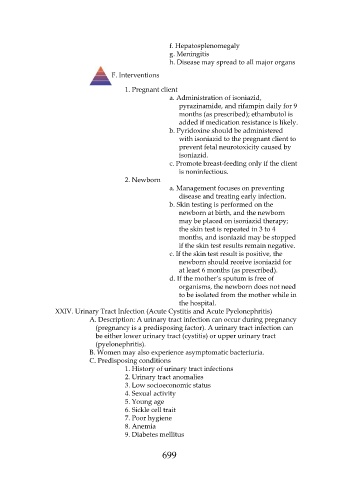Page 699 - Saunders Comprehensive Review For NCLEX-RN
P. 699
f. Hepatosplenomegaly
g. Meningitis
h. Disease may spread to all major organs
F. Interventions
1. Pregnant client
a. Administration of isoniazid,
pyrazinamide, and rifampin daily for 9
months (as prescribed); ethambutol is
added if medication resistance is likely.
b. Pyridoxine should be administered
with isoniazid to the pregnant client to
prevent fetal neurotoxicity caused by
isoniazid.
c. Promote breast-feeding only if the client
is noninfectious.
2. Newborn
a. Management focuses on preventing
disease and treating early infection.
b. Skin testing is performed on the
newborn at birth, and the newborn
may be placed on isoniazid therapy;
the skin test is repeated in 3 to 4
months, and isoniazid may be stopped
if the skin test results remain negative.
c. If the skin test result is positive, the
newborn should receive isoniazid for
at least 6 months (as prescribed).
d. If the mother’s sputum is free of
organisms, the newborn does not need
to be isolated from the mother while in
the hospital.
XXIV. Urinary Tract Infection (Acute Cystitis and Acute Pyelonephritis)
A. Description: A urinary tract infection can occur during pregnancy
(pregnancy is a predisposing factor). A urinary tract infection can
be either lower urinary tract (cystitis) or upper urinary tract
(pyelonephritis).
B. Women may also experience asymptomatic bacteriuria.
C. Predisposing conditions
1. History of urinary tract infections
2. Urinary tract anomalies
3. Low socioeconomic status
4. Sexual activity
5. Young age
6. Sickle cell trait
7. Poor hygiene
8. Anemia
9. Diabetes mellitus
699

